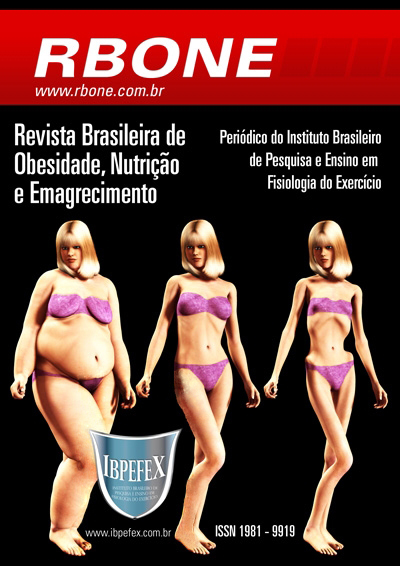Anthropometric profile analysis, physical activity level and physical fitness in students from a public university
Abstract
Physical activity reduces the cardiovascular risk, contributes to control of body weight and improves physical fitness. For this reason, this study searched to understand physical activity, physical fitness and anthropometric profile of students from a public university. Quantitative descriptive research was made through a cross-sectional study with 87 participants. The tools were IPAQ (International Physical Activity Questionnaire) short version and PARQ (Physical Activity Readiness Questionnaire) questionnaires, as well as anthropometric analysis and 1RM physical fitness tests based on Dohoney's equation, resistance by ASTRAND protocol and flexibility by means of Macrae test. The variables were analyzed in Bioestat 5.0 using the Mann Whitney, Spearman and ANOVA tests, considering a significance level of 95% (p<0.05). It was identified 21.84% of the participants were overweight and 55.17% were considered able to perform physical exercises. The following correlations were observed VO2 max x body mass index (r=-0.38), 1RM upper limbs x body mass index (r=0.38) and 1RM lower limbs x body mass index (r = 0.55). In conclusion, the majority of students were normal BMI, active or very active in relation to the practice of physical activity and were adequate flexibility level.
References
-Carneiro, M.N.L.; Lima, P.S.; Marinho, L.M.; Souza, M.A.M. Estado nutricional de estudantes universitários associados aos hábitos alimentares. Rev. Soc. Bras. Clin. Med. Vol. 14. Núm. 2. p. 84-88. 2016.
-Compeán-Ortiz, L.G.; Trujillo-Olivera, L.E.; Valles-Medina, A.M.; Reséndiz-González, E.; García-Solano, B.; Pérez, B. D. A. Obesity, physical activity and prediabetes in adult children of people with diabetes. Rev. Latino-Am. Enfermagem. Vol. 25. 2017.
-Duncan, B. B. Medicina Ambulatorial: condutas de atenção primária baseadas em evidências. 4ª edição. Porto Alegre. Artmed. 2013.
-Gasparetto, R.M.; Costa e Silva, R.C. Perfil antropométrico dos universitários dos cursos de nutrição, enfermagem, fisioterapia e educação física do Centro Universitário La Salle, Canoas-RS. Revista Associação Brasileira de Nutrição. Vol. 4. Núm. 5. p.29-33. 2015.
-Governo Brasileiro. Instituto Brasileiro de Geografia e Estatística. 2019. Disponível em: https://cidades.ibge.gov.br/brasil/se/lagarto/panorama. Acesso em: 29/09/2019.
-Herdy, A.H.; Uhlendorf, D. Valores de referência para o teste cardiopulmonar para homens e mulheres sedentários e ativos. Arq. Bras. Cardiol. Vol. 96. Núm. 1. p. 54-59. 2011.
-Mcardle, W.D.; Katch, F.; Katch, V.L. Fisiologia do Exercício: Nutrição, Energia e Desempenho Humano. 7ª edição. Rio de Janeiro. Guanabara Koogan. 2011.
-Medina-Moya, J.L.; Cónsul-Giribet, M. Strengths and weaknesses of Problem Based Learning from the professional perspective of registered nurses. Rev. Latino-Am. Enfermagem. Vol. 22. Núm. 5. p.724-730. 2014.
-Mesquita, R.B.; Ribeiro, L.R.G.; Dias, M.C.; Avelar, T.B.; Probst, V.S. Relação entre o índice de massa corpórea e a capacidade máxima de exercício em homens e mulheres. ASSOBRAFIR Ciência. Vol. 1. Núm. 1. p. 23-33. 2010.
-Portal UFS. Campus de Lagarto. 2018. Disponível em: http://lagarto.ufs.br/pagina/18926-campus-universitario-professor-antonio-garcia-filho. Acesso em: 29/09/2019.
-Queiroga, M. R. Testes e medidas para avaliação da aptidão física relacionada à saúde em adultos: Nutrição, Energia e Desempenho Humano. Rio de Janeiro. Guanabara Koogan. 2005.
-Sampaio, L. R. Avaliação nutricional. Salvador. EDUFBA. 2012.
-Santos, L. R.; Brito, E. C. C.; Neto, J. C. G. L.; Alves, L. E. P; Alves, L. R. A.; Freitas, R. W. J. F. Análise do sedentarismo em estudantes universitários. Rev. Enferm. UERJ. Vol. 22. Núm. 3. p. 416-422. 2014.
-Silva, E. C.; Tucci, A. M. Estudo transversal sobre o uso de risco de álcool em uma amostra de estudantes de uma universidade federal brasileira. J. bras. psiquiatr. Vol. 63. Núm. 4. p. 317-325. 2014.
-Silva, M. R. S. Perfil antropométrico e hábitos alimentares dos estudantes de nutrição. 2015. TCC Graduação em Nutrição. Universidade Federal da Paraíba. João Pessoa. 2015.
-Souza, S. C.; Dourado, L. Aprendizagem baseada em problemas (abp): um método de aprendizagem inovador para o ensino educativo. Holos. Vol. 5. p. 724-730. 2015.
-Stringuetta-Belik, F.; Shiraishi, F. G.; Silva, V. R. O.; Barretti, P.; Caramori, J. C. T.; Bôas, P. J. F. V.; Martin, L. C.; Franco, R. J. S. Maior nível de atividade física associa-se a melhor função cognitiva em renais crônicos em hemodiálise. J. Bras. Nefrol. Vol. 34. Núm. 4. p. 378-386. 2012.
-Trape, Á. A.; Marques, R. F. R.; Lizzi, E. A. S.; Yoshimura, F. E.; Franco L. J.; Zago, A. S. Associação entre condições demográficas e socioeconômicas com a prática de exercícios e aptidão física em participantes de projetos comunitários com idade acima de 50 anos em Ribeirão Preto, São Paulo. Rev. bras. epidemiol. Vol. 20. Núm. 2. p.355-367. 2017.
-World Health Organization. Global recommendations on physical Activity for health. 2010.
-Zenatti, A.; Luz, A. C.; Oliveira, R. V. Efeitos na flexibilidade e força de mulheres fisicamente ativas resultantes da prática de um programa de treinamento de 2 meses de hatha yoga, modalidade jayaprána yoga. Revista Brasileira de Obesidade, Nutrição e Emagrecimento. São Paulo. Vol. 5. Núm. 30. 2011. Disponível em: http://www.rbone.com.br/index.php/rbone/article/view/283/269.
Copyright (c) 2022 Lucas Buri dos Anjos Fonseca, Franciely Oliveira de Andrade Santos, Carlos José Oliveira de Matos

This work is licensed under a Creative Commons Attribution-NonCommercial 4.0 International License.
Authors who publish in this journal agree to the following terms:
- Authors retain the copyright and grant the journal the right of first publication, with work simultaneously licensed under the Creative Commons Attribution License BY-NC which allows the sharing of the work with acknowledgment of the authorship of the work and initial publication in this journal.
- Authors are authorized to enter into additional contracts separately for non-exclusive distribution of the version of the work published in this journal (eg, publishing in institutional repository or book chapter), with acknowledgment of authorship and initial publication in this journal.
- Authors are allowed and encouraged to post and distribute their work online (eg, in institutional repositories or on their personal page) at any point before or during the editorial process, as this can bring about productive change as well as increase impact and impact. citation of published work (See The Effect of Free Access).






